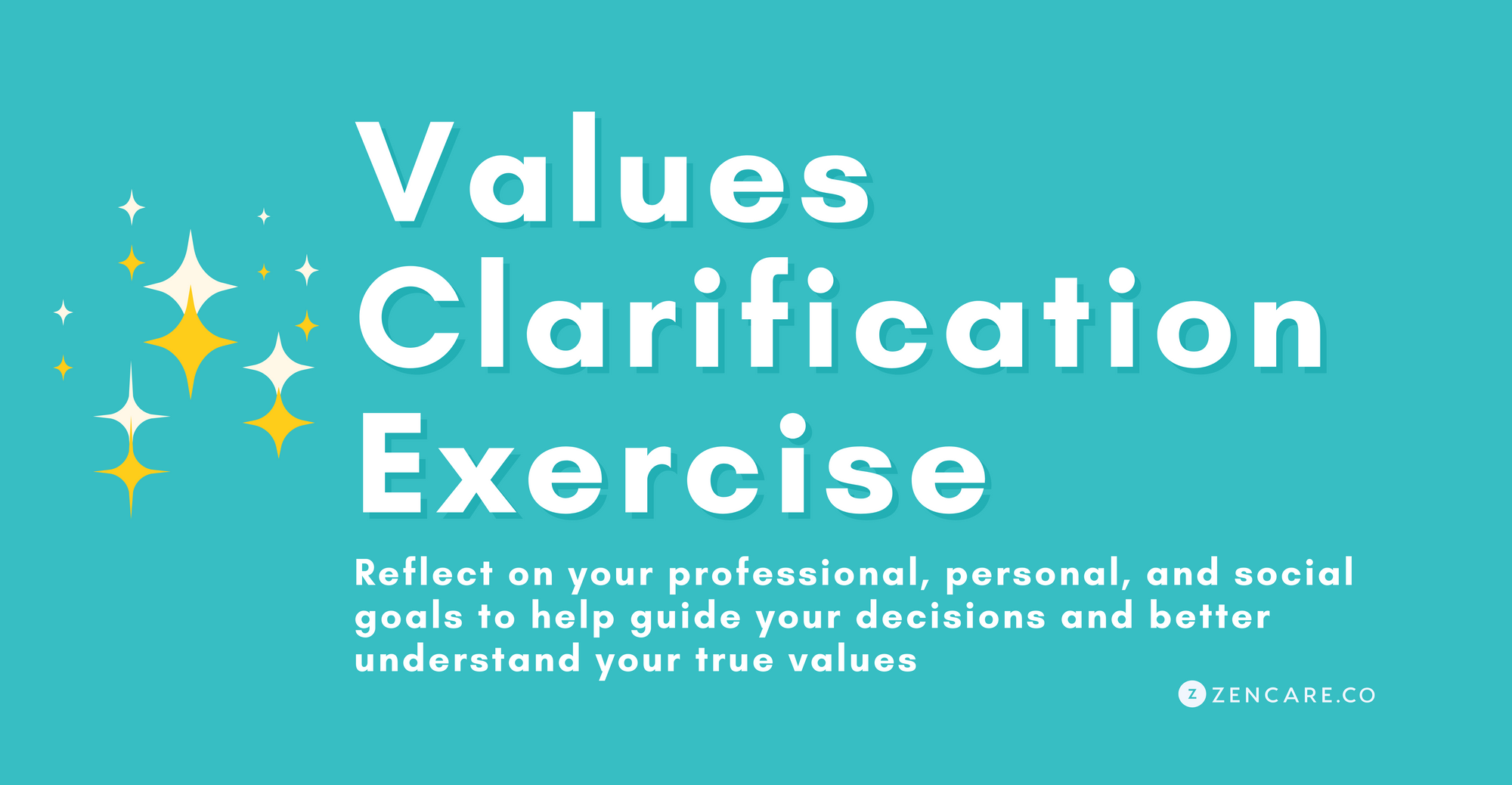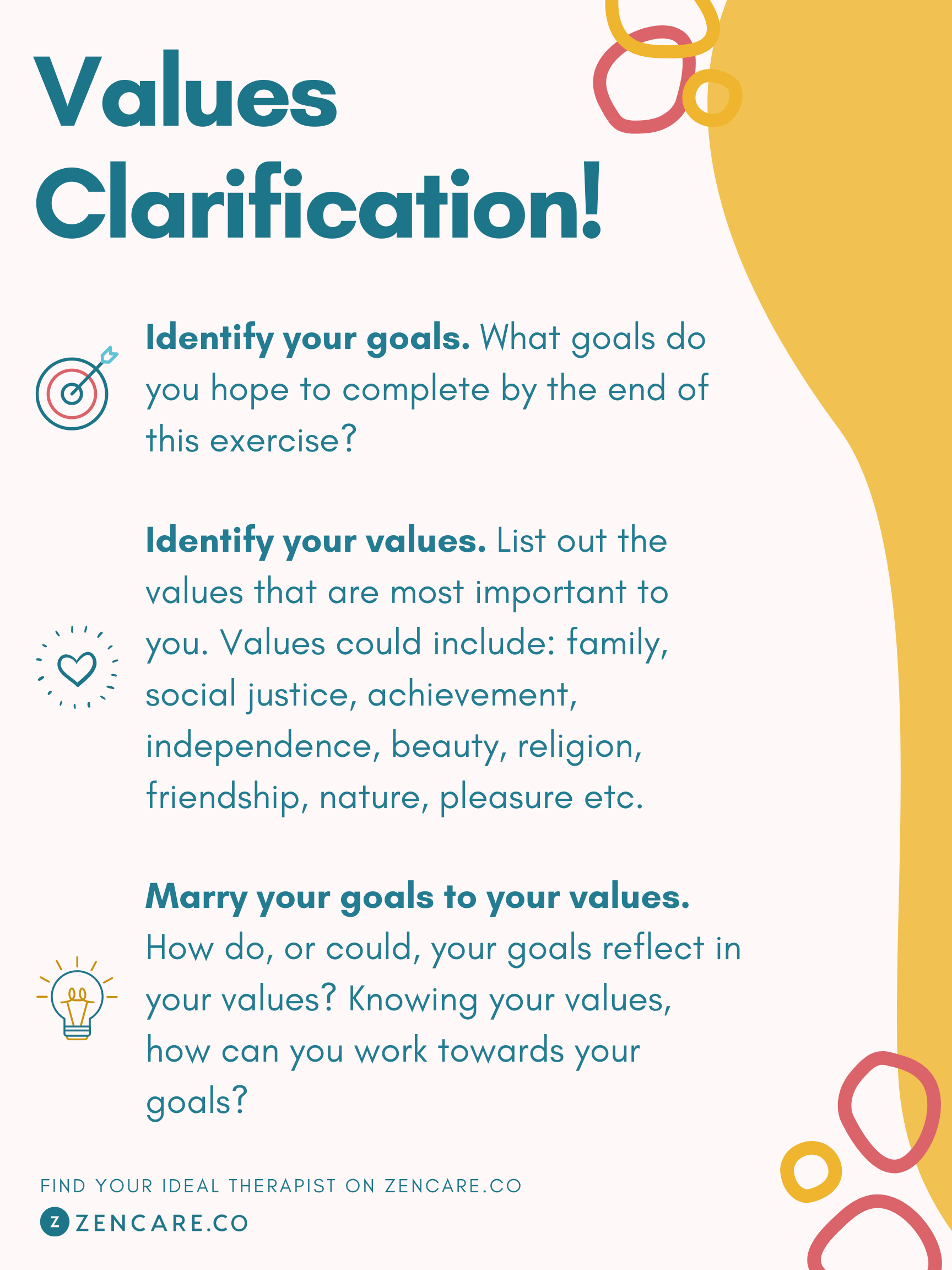Today’s world is fast-changing and dynamic – it seems that these days, nothing is what we expect it to be. So how are we supposed to make any decisions in this current state of mind? One way is to turn to your values: The guiding forces behind our thoughts and behaviors, those that are asynchronously stable.
By becoming aware of your values and embracing them as your source of truth and authenticity, you can clarify your goals and purpose, and answer any outstanding questions about what is right or wrong for you.

What is a values clarification exercise?
A values clarification exercise is a practice often found in cognitive behavioral therapy (CBT). Completing a values clarification exercise is a great way to make any unconscious values explicit, which not only helps you in decision-making of identity-finding but also helps others (like your therapist!) support you by letting them know what’s important to you.
This exercise holds up a magnifying glass to what you believe in with your whole heart, what’s dominant in your choices, and what’s essential to have in your life.
Here's when values clarification exercises can help
Values clarification exercises are helpful at any point, but are especially powerful during times of life transition, confusion about decisions, or personal and professional burnout.
Some examples of sticking points that values clarification exercises might help with are the following:
- Professional environment. What do I enjoy/not enjoy about my job? Do I find fulfillment from work? What direction should my career take?
- Romantic relationships. What is healthy/unhealthy about my relationship? Where is this relationship headed? And where do I want it to head?
- Transitions. Where am I going? What is my dream? How do I want to live my life? What should I include/exclude from my life?
- Social life. Who are my friends? Who are my best friends and why? What energy do I put into/get out of my friendships and relationships?
- Physical health. How do I feel? How’s my self-esteem doing? How do I feel about myself?
- Mental health. How do I feel, day-to-day? Am I happy? What would make me happy? What other emotions do I feel and why do I feel these?
1. Identify your goals
A great place to start for a values clarification exercise is to identify your goal(s). With what purpose are you starting this exercise? What do you hope to achieve by the end of the values clarification exercise?
Figuring out your goal will help focus the practice and help you get the most out of it. Some example goals include:
- I will find a good place to live
- I will graduate from college
- I will get a promotion and further my career
- I will learn a new language
- I will commit to a partner in a romantic relationship
- I will mend my relationship with my family
- I will get out of my comfort zone more often
- I will meet a financial goal
After you’ve picked a goal and set your intention, it’s now time to find out what your values are!
2. Identify your values
There are many different types of values clarification exercises, most of which include a written component to further reflection.
Once extremely helpful exercise is to list out all of your top values or circle values that are important to you out of a large list. Values could include things like the following: Family, loyalty, social justice, achievement, independence, beauty, health, art, expression, creativity, diversity, fairness, freedom, friendship, nature, and pleasure.
From here, explore why these values are important to you. Ask yourself questions like:
- How do these values guide your behavior?
- Where did your values come from?
- Did someone teach you these values or do you remember examples of seeing these values in action?
- How would you rank your values, from most significant to least?
- Why did you rank the values in this order?
Next, try journal about these values in action. While the exercise is to identify your values, the more time spent reflecting on why those are your values and what they look like in your daily life will clarify your beliefs and boost your understanding of yourself. This understanding, in turn, can give you a few ideas about how to meet your goal.
3. Marry your goals to your values
After you’ve decided on your goals and explored what values are important to you, it’s now time to marry your goals to your values.
Ask yourself:
- How do your goals reflect in your values?
- How do your values reflect on your goals?
- Knowing your values, how can you work towards your goals?
These ideas can be written out in a journal, thought about over an extended amount of time, discussed with friends, family, or your therapist. Some people thrive on a “homework” assignment meant to be introspective about values, others find the same answers from focusing their mind and thoughts on the topic.
However this looks for you, completing a values clarification exercise is a great way to use your truths to guide your decisions and maintain the ever-important authenticity of knowing yourself and being yourself.
